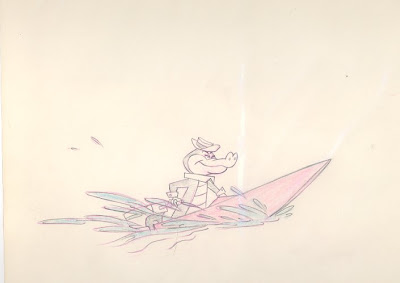Jellystone Park is the setting for all four weekend newspaper comics in the Yogi Bear series 50 years ago this month, though Ranger Smith and Boo Boo both get a weekend off.
These are taken from the Ottawa Citizen; for a change, someone decided to photocopy and scan the colour comic sections for that month and post them on-line (we’re out of luck for the following month). In Yogi’s case, there’s one comic per page, so that’s why there are four rows instead of three (if you were lucky) like in American papers (which fit two strips on a page). This wasn’t unusual; the Vancouver papers did the same thing then.
Someone will, I hope, identify which of these are drawn by Harvey Eisenberg (I suspect the first one, at least). And you can click on each comic to enlarge it.
![Yogi Bear comic, November 4, 1962]()
November 4th has some great little touches. Note the ranger flapping his feet in mid-air in the opening panel as a woodchuck looks on. Yogi’s reacting beautifully with his whole body, not just standing there. Later, Yogi’s pic-a-nic basket meal is interrupted by the plot; I don’t know how often that happened. The “fur coat” line sounds like something Warren Foster would throw into the animated show.
![Yogi Bear comic, November 11, 1962]()
Everyone was in a Lodge in the 1950s and ‘60s, it seems. Rangers included. November 11th features a meeting of the Royal Order of Rangers. Being refined gentlemen, no one wears a hat during the meeting. Again, the opening panel has a nice layout with an interesting perspective. A shame that newspapers skipped the optional top row (always written so if it wasn’t printed, the plot wouldn’t be disrupted). Boo Boo appears solely for reaction purposes in the final panel.
![Yogi Bear comic, November 18, 1962]()
Yogi bounces with his legs up in excitement at the prospect of food in the November 18th strip (see the second panel). There’s a silhouette panel as well, and the food vendor has the collar-height ear Walt Clinton gave characters in the H-B TV cartoons.
![Yogi Bear comic, November 25, 1962]()
Ranger Smith’s wife makes an appearance for the first time since February in the November 25th comic. She’s changed her hair-style in the interim. I love the reclining, vibrating cow in the final panel. Smith’s boss “Captain”? Shouldn’t he be “Superintendent”? By the way, notice how the ranger station is at about the same angle as the food vendor’s cart in the previous week’s comic? You get a good look at two sides.
My sources to get copies of these comics (and the various news stories you’ve read over the years here) have dried up so it will be tough to continue presenting these; another reason the blog will cease once material in my archive is used up.
These are taken from the Ottawa Citizen; for a change, someone decided to photocopy and scan the colour comic sections for that month and post them on-line (we’re out of luck for the following month). In Yogi’s case, there’s one comic per page, so that’s why there are four rows instead of three (if you were lucky) like in American papers (which fit two strips on a page). This wasn’t unusual; the Vancouver papers did the same thing then.
Someone will, I hope, identify which of these are drawn by Harvey Eisenberg (I suspect the first one, at least). And you can click on each comic to enlarge it.

November 4th has some great little touches. Note the ranger flapping his feet in mid-air in the opening panel as a woodchuck looks on. Yogi’s reacting beautifully with his whole body, not just standing there. Later, Yogi’s pic-a-nic basket meal is interrupted by the plot; I don’t know how often that happened. The “fur coat” line sounds like something Warren Foster would throw into the animated show.

Everyone was in a Lodge in the 1950s and ‘60s, it seems. Rangers included. November 11th features a meeting of the Royal Order of Rangers. Being refined gentlemen, no one wears a hat during the meeting. Again, the opening panel has a nice layout with an interesting perspective. A shame that newspapers skipped the optional top row (always written so if it wasn’t printed, the plot wouldn’t be disrupted). Boo Boo appears solely for reaction purposes in the final panel.

Yogi bounces with his legs up in excitement at the prospect of food in the November 18th strip (see the second panel). There’s a silhouette panel as well, and the food vendor has the collar-height ear Walt Clinton gave characters in the H-B TV cartoons.

Ranger Smith’s wife makes an appearance for the first time since February in the November 25th comic. She’s changed her hair-style in the interim. I love the reclining, vibrating cow in the final panel. Smith’s boss “Captain”? Shouldn’t he be “Superintendent”? By the way, notice how the ranger station is at about the same angle as the food vendor’s cart in the previous week’s comic? You get a good look at two sides.
My sources to get copies of these comics (and the various news stories you’ve read over the years here) have dried up so it will be tough to continue presenting these; another reason the blog will cease once material in my archive is used up.

































































































































































